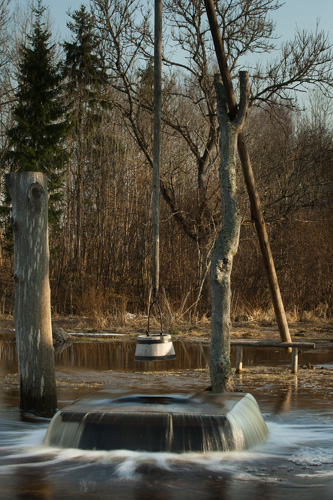The chant of the Tuhala Witch Well
Composer: Urmas Sisask
Listen to the chant:
Over 55 000 signatures had been collected at the end of April 2010 to stop the planned large-scale quarrying of limestone in the Tuhala-Nabala area. The issue is still unresolved at the moment (beginning of May, 2010).
More about the background and a link to more information and the protest list is at the end of this article
A visit to Ants Talioja, to meet the spirit of Tuhala:
Tuhala, underground rivers, plans for limestone quarries, worried inhabitants, disappointed enterprises. And an uncaring government?
When the idea was born to go to Tuhala to visit Ants Talioja together with geologists and environmental protectionists, so that we would get some idea of his fight against the limestone strip mines, I tried to remember when I first had visited Ants. For me he has always been there. A constant presence. With my friend Jaan Riisa we have seen the growth of the Tuhala Witches’ Well to a so to say great news story. It has been hammered into our consciences as the essence of three men: geologist Ûlo Heinsalu’s knowledge, sculptor Ülo Õun’s sculpture park and the limitless enthusiasm and dedication of Ants.
The story of the Tuhala area has become a vital part of Estonia’s culture, as has the tireless teller of the story, Ants Talioja.
One can discuss endlessly with Ants: energy columns, underground rivers and all that goes with it. Many of my acquaintances don’t agree with his views, but there is nobody who does not respect Ants. Thanks to my one-time colleague, journalist Tiit Kändler, I became familiar with the concept of „genius loci”„the spirit of a place” and this is as I see it, the most appropriate way to characterize Ants. Such people carry a value, they must be preserved.
“Green Gate” went to visit Ants on April 28, 2008, with geologists Rein Einasto and Rein Perens and environmentalist Marek Strandberg.
On a beautiful spring day, beside the Tuhala Witches’ Well, at a round stone table, Ants at first presented the results of the geo-radar surveys of the Finnish company Roadscanners OY. It was said that in Tuhala as well as Nabala wide-spread networks of underground rivers had been found.
As usual a fierce argument broke out. Since the survey results were still not checked by other methods, truth will be revealed some time in the future.
The most inflammable theme was the fact, frightening for people in the Tuhala area, that three enterprises - OÜ Paekivitoodete Tehas, OÜ Merko Kaevandused and AS Kiirkandur – were waiting for permission to open seven limestone quarries in the area. I listened to the discussion around the table about how the effect of the quarrying on the groundwater in the area should be modelled, but at the same time I was beset by the feeling that not all this, but something quite else, might be the most important thing here,.
Exile Estonian Enn Andersoni was involved in the saving of the ancient Abu Simbel temple complex in Egypt from the flooding Nasser Sea. It was lifted up 64 metres higher ...
How to save the spirit of Tuhala? Is an engineer’s knowledge sufficient for this? As would be expected from the company present there, questions were also taken up about how the problem of threatened drinking water resources appeared in the context of rainy and water-rich Estonia; was a four-lane motorway between Tallinn and Tartu really needed; should government favour development of communal transport etc, etc.
But what finally persisted was recognition of a grave shortcoming in the organisation of our community. The government has shifted responsibility for the inventory of geological resources to the companies named above. A company buys property, orders investigations and the environmental impact evaluation. It invests a great sum of money into it all – and from this evidently an assumption of permission to start digging and getting a return for the money is created.
The local community with its communal interests is left in the role of the orphan. Of course nobody wants an industrial landscape on their doorstep and in their backyard. But the quarrying has to be done somewhere if we want a four-lane Tallinn-Tartu motorway.
Only - do we really want it?
Author: Tiit Lepik, Roheline Värav (Green Gate), May 9, 2008.
Translation: Liis
About Tuhala – brief background
Tuhala and nearby Nabala constitute the largest karst landscape region in Estonia with caves, underground rivers, wells and sinks.
Tuhala lies south-southeast of Tallinn, at the Tallinn-Tartu main road. It is a protected landscape area since 1989, and best known for the "Witch Well”, Nõiakaev, that overflows with water ("boils”) at times with high waterflow in neighbouring rivers. The overflow may last for days up to weeks.
Tuhala was first described in scientific literature in 1782 by professor Wilhelm Humpel. Investigations in the latter part of the 20th century and up to now have revealed a complex network of underground rivers and water flows.
Some of the proposed mining is planned to be carried out at a depth of some 20 metres and below current groundwater level. The stone is primarily needed for a planned 4-lane motorway Tallinn –Tartu. There is disagreement over the results of the latest geo-hydrological surveys, their interpretation and the models used to show the effects on hydrology of the quarrying.
Read more about Tuhala and sign the protest list at









